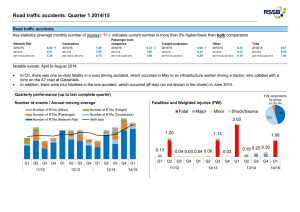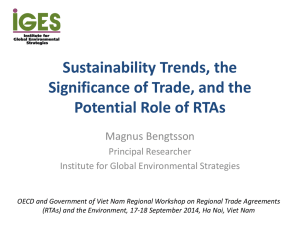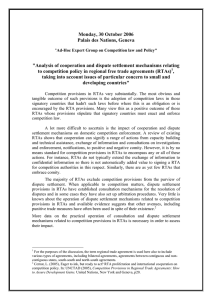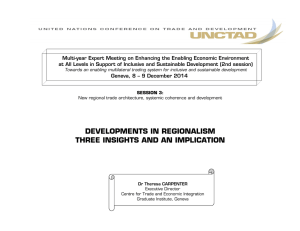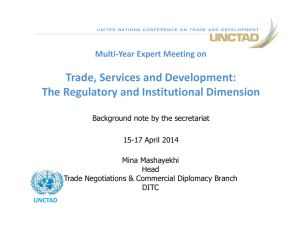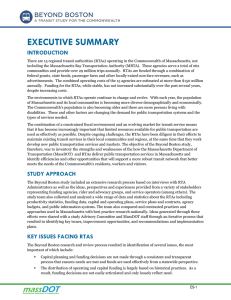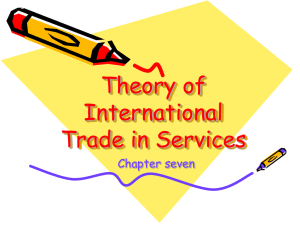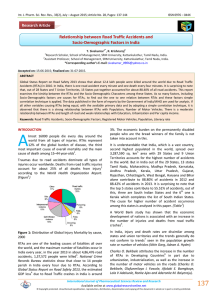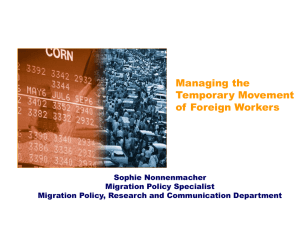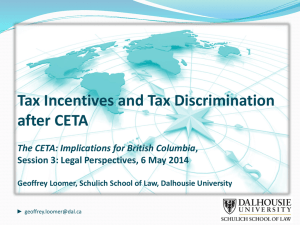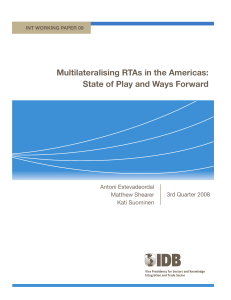Mode 4: current regimes
advertisement
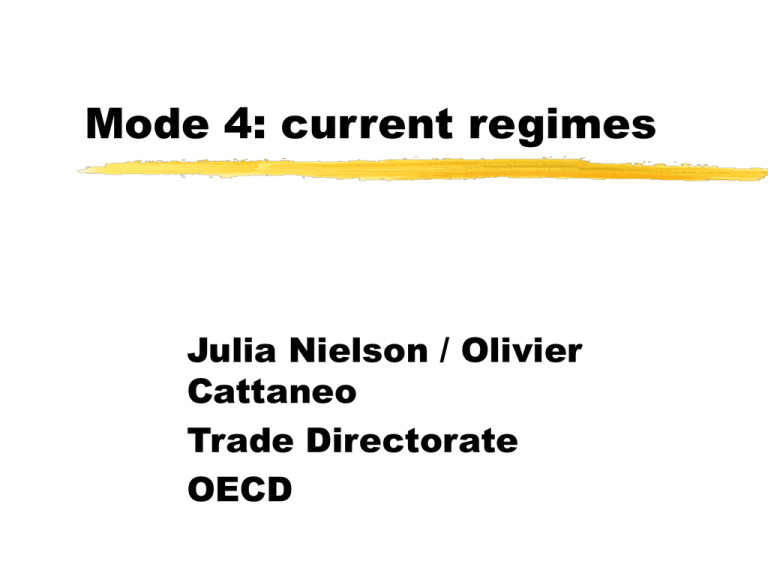
Mode 4: current regimes Julia Nielson / Olivier Cattaneo Trade Directorate OECD Current regimes Country case studies US and Australia best data, well-developed schemes transparency of information focus on general lessons/insights Treatment of labour mobility in RTAs different models detail distributed, focus on general patterns Country case studies GATS schedules set out commitments BUT may not reflect current regime don’t mention visa categories Need to look at actual temporary entry systems operated by migration authorities sense of scale of entry terms, conditions and means of entry But this requires some “mapping” of mode 4 coverage…. Country case studies Different systems, different policy communities -migration and trade (mode 4) categories not the same information required not always the same Some interpretations involved level of detail not always sufficient to judge extent of mode 4 coverage Country studies - issues Migration categories do separate between temporary and permanent and often between short-term visit and longer term (but still temporary) presence Within temporary entrants, also distinguish type of occupation (skill level or perhaps sector or specific profession - e.g., medical) country of origin Country studies - issues Migration categories do NOT generally distinguish between service and nonservice activities e.g., business visitors or “company managers” etc could involve service and non-service sector activities Not always clear what might be a service e.g., temporary agricultural workers OR suppliers of fruit-picking services Even where service sector indicated, may not correspond to W/120 categories Country studies - issues Also not always clear the extent to which an activity is commercial e.g., amateur and professional athletes Some activities are also “mixed modes” e.g., industrial/occupational trainees (mode 2 consumption or mode 4?) exchange programs - students (mode 2) and lecturers (mode 4)? Working Holiday Makers - mode 2 tourists or mode 4 service suppliers? Country studies - issues Definition question foreign workers working on contract for domestic companies vs as employees of domestic companies language of GATS vs members’ commitments But are issues can be difficult to know type of contract not a migration distinction have included them without prejudice to determination on this point Country study - findings Temporary entry increasing General requirement for a certain level of skills or education Sponsored workers required to be paid the same rates as nationals and same working conditions All subject to general visa conditions regarding e.g, good health and character families often included Country study - findings Periods of stay vary according to type of entrant extensions generally (but not always) possible and subject to a maximum limit Detailed breakdown by category provide good data on numbers and country of origin of key entrants e.g., temporary visitors for business, intracorporate transferees and specialty occupation workers in the US; business visitors, medical and educational in Australia Country study - findings Specific regimes in areas of particular interest e.g., sport, entertainment, medical linked to mode 3 - investors or intra-corporate transferees/regional headquarters agreements GATS - “service sellers” visa in Australia Attempts to minimise any negative impacts on nationals (e.g., labour market testing) Special facilitation schemes for certain nationals, including on the basis of RTAs. RTAs Wide variety - from total freedom of labour to facilitation of existing access only reflects, e.g., geographical proximity; levels of development, cultural and historical ties. while GATS is limited to temporary movement of service suppliers, some RTAs go beyond this free movement of labour or limited movement, but beyond service suppliers RTAs RTAs not providing full labour or service supplier mobility tend to use GATS-type carve outs exclude permanent migration and access to labour market don’t impinge on right to regulate entry and stay of individuals Most RTAs are subject to general immigration legislation parties retain discretion to grant, refuse and administer residence permits RTAs Symbiotic relationship between RTAs and the GATS NAFTA provided model for GATS other RTAs use GATS model (e.g., EUMexico, US-Jordan) RTAs also feed off each other Latin American agreements; proposals in FTAA resemble NAFTA and EU-Mexico RTAs Some cover movement only under mode 4 in services chapter e.g., MERCOSUR, US-Jordan Some group all mobility separately e.g, Group of Three, Japan-Singapore others include reference to mobility of key personnel in investment provisions e.g., ASEAN, proposals in draft FTAA or sectoral chapters e.g., EU-Mexico in financial services RTAs Facilitated movement of people does not always equal right to provide specific services need to read in conjunction with liberalisation commitments on particular service sectors for all types of agreement agreements can exclude certain service sectors from coverage; apply special rules to certain sectors professions remain governed by national regulations on licensing and qualifications RTAs Need to be careful comparing RTAs (apples and oranges) some restrictions are unnecessary when the RTA doesn’t offer a certain kind of access e.g., EU specification that certain jobs reserved for nationals only required in context broad mobility some RTAs offer broad mobility, but exclude some sectors; others cover all sectors but limit mobility to certain defined groups. RTAs Paper creates number of broad groupings based on text, not implementation full mobility of labour EU, EEA, EFTA, COMESA, Trans-Tasman Travel Arrangement market access for certain groups, including beyond service suppliers and/or agreements grouping all mobility in a separate chapter CARICOM, NAFTA, Canada-Chile, Europe Agreements, Japan-Singapore, Group of Three RTAs Agreements using GATS model with some additional elements US-Jordan, EU-Mexico, AFTA, Euro-Med (Morocco, Tunisia), New Zealand-Singapore Agreements using the GATS model MERCOSUR Agreements providing no market access but facilitated entry APEC, SAARC No provisions or works in progress CEFTA and FTAA, SADC respectively RTAs Additionally, some RTAs create special visa schemes or other types of managed entry Trade NAFTA visas APEC Business Travel Card Experience might be interesting for GATS indicates that the more diverse the membership, more scope allowed for existing regimes administrative capacity a major issue Conclusion Both RTAs and country case studies underline range of options for access, calibrated to national needs need for close policy coordination and dialogue between migration and trade authorities need to consider how to implement commitments and administrative capacity required Thank you
